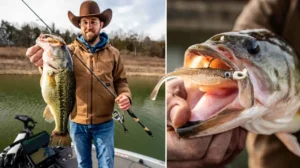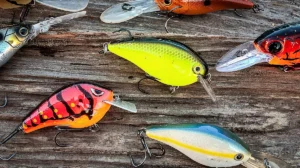Few fishing prognostics would have predicted pro bass angler Tommy Biffle to have a chance at claiming the Angler of the Year (AOY) title at the Professional Anglers Association’s (PAA) final event last week.
Biffle entered the event in second place behind Edwin Evers in the AOY race, and all who follow the sport of tournament fishing know Biffle’s reputation has been built around his skills at flipping and pitching in shallow, dirty water. The tournament was on Missouri’s Table Rock Lake and conditions were crystal-clear water, calm winds and sunny skies. Fishing reports for weeks had been showing the “magic depth” for success to be around 40 feet.
The Wagoner, Okla., angler admitted he had a horrible practice on the lake. “I found tons of shad shallow way up in the King’s River but could only catch little bass around them,” Biffle explained. “I fished shallow. I fished deep. But over my three days of practice, I don’t think I had five fish that would have measured (15-inch minimum for bass on Table Rock Lake). I had pretty well decided I was just going to fish docks down lake as my strategy.”
Biffle’s struggles were genuine on day one. He managed only three keeper bass that totaled little more than 6 pounds. The two smallmouths and one largemouth came off softball-sized chunk rock points in the James River area where he dragged his namesake Biffle Bug in Sooner Run color in 6 to 8 feet of water on an 11/16-ounce Biffle Hard Head.
He returned to the area on day two, but there was no breeze on this day and the bass were not cooperating at all. He knew he had to make a change to even have a chance at making the cut to 24 anglers after this day, much less winning the AOY title.
It was late morning when things finally clicked for Biffle. That’s when he saw a small bass make a run at his Biffle Bug from the shade of an isolated “willow-type” tree in inches of water. He also noticed sunfish, gizzard shad and little minnows active in the area. “I instantly had recollections of my clear water tournament wins at Oneida (2006 BASS event in New York) and Cherokee (2010 PAA event in Tennessee), both of which centered around fishing shaded cover in less than two feet of water,” he said. “Now I had a real plan of what to do.”
Biffle explained that finding the isolated trees in the water on the lower end of the lake was easier said than done. He would run the banks with his boat on plane looking for the specific cover, but often was fooled by trees being on the shore instead of in the water. “I finally figured out if I used an angled approach to any trees spotted, I could tell pretty quick whether they were in the water or not, and that saved me valuable time in looking for them. Then if I saw sunfish and shad nearby, too, I knew I was going to catch one.”
Biffle went on to catch a limit of five fish this second day, totaling 13.60 pounds, moving him up to 17th place and making the cut to fish the third and final day. He also held the vision of one tree at which he had hooked and lost a 4-pound fish twice that day.
Day three conditions were indeed the same as the day before. Winds were calm and the sun was bright. The conditions played perfectly for Biffle’s “shade pattern.” He returned to his hunt and fish strategy of finding isolated trees that were in only inches of water, saying most of his fish came from spots that were in less than 1 ½-feet of water. Although the 4-pounder from the previous day never bit again, Biffle’s 6.21-pound big fish came from nearby.
“It turned out to be a really solid pattern for me. I had a lot of confidence I would catch a good largemouth if the spot had shade and baitfish. The only real problem was there weren’t a lot of spots like this on the lake. I had to do lots of running and looking.”
Biffle’s day three catch had his five-fish limit weighing in at 16.45 pounds. It was the heaviest bag of the tournament and it was enough to secure his AOY title for the 2010 PAA tour.
“I’ve been close in angler-of-the-year races before, but this is the first time I’ve ever won one. It’s a great feeling knowing the level of competition here from both the BASS and FLW tours.”
But the real story from Table Rock isn’t about an angler winning another title and more prize money. Instead it’s about the lesson in bass fishing in which Biffle has been holding class on now for most of the last two years.
What anglers everywhere should be making note of is that bass can be shallow in just about any kind of water, and at just about every time of year. Biffle has had a phenomenal two years of success along the BASS and PAA tournament trails, making a check in almost every one he has fished to contribute to his more than $450,000 winnings over the last two seasons alone.
Another lesson learned is that in order to be consistently competitive for AOY-type credentials, an angler should fish to his strengths. Sure, Biffle can fish deep, but without a doubt his strength lies in shallow water fishing. Over his more than 35 years of tournament fishing, he estimates that 95 percent of his catches have come from less than five feet of water. That’s pretty amazing when you take into consideration that the tournament schedules he competes in typically run from February through October.
Lastly, having total confidence in a bait and technique is essential, and you can’t help but associate certain anglers with specific baits. Legendary angler Charlie Campbell is known for his prowess with a Zara Spook. TV fisherman Jimmy Houston is a famed spinnerbait angler. For years David Fritts dominated the tournament trail with a deep-diving crankbait. Biffle made his career with a jig.
More recently though, Biffle has relied almost exclusively on his Biffle Bug that he designed for Biffle and his Bug.
He says it is the bait’s versatility that gives him the confidence to have six to eight of his rods in every tournament rigged with the bait.
It is true that the Larew creature-style bait probably has more features built into it than does any other soft plastic lure of its kind, and that’s not by accident.
“The Biffle Bug is like a dozen different baits in one,” Biffle said. “It has the ridges around the body for added vibration and ‘sound’ when it comes in contact with structure. It has a flat body with a wide, flat tail, and the combo makes it a great glide bait. The tail is thin and cupped, and the cupping gives it a unique fall and provides even more action to the tail. The head is solid to hold a heavy-wire hook, but the body is hollow.”
“The hollow body serves several functions. First, it allows for higher hookups than normal because the hook doesn’t have to penetrate a lot of plastic. Also, I can easily add or remove a rattle by compressing the body. The rattle gives me a noise bait when I’m fishing dirty water. Or I can add a piece of foam to the inside to give me a high-floating bait for a Carolina Rig.”
“Then there’s the Biffle Bug’s legs. Leave them on and you have a swimming bait that kicks like crazy and causes all kinds of commotion. I can swim it around stumps and docks. Pinch the legs off at their score marks at the body, and I have a subtle bait that can enter the water without a splash when flipping or pitching.”
“Finally, when I rig it on one of the new Biffle Hard Heads by Larew, I basically have a soft plastic crankbait. The loosely attached hook on the football head allows the Bug to dance all over the place. This is a combo that has been especially deadly for me this year, and I can’t believe the number of calls and emails I get from anglers all across the country telling me of their success with this rig. The outdoor press has even given this technique its own name now – bottom buggin’ – and when was the last time you can remember a truly new technique to come along?”
“As a tournament angler, it’s always hard to give up a competitive advantage. But as much as I would love to have this bait all to myself, it has been rewarding to know that something I helped create is helping a lot of bass fishermen catch more fish.”
So, what’s next for this angler who has been among the hottest on the tournament trail over the past couple of seasons?
“Well, I think I’ll go fishing,” he responded. “I keep hearing the crappie are biting here on Ft. Gibson (his nearby home lake), and I love to winter crappie fish. I also have some bowhunting planned. Also, it won’t be that long until the Bassmaster Classic is here again, and I can’t help but give that some thought, too.”
One thing is for certain, the 2011 Classic scheduled for February at New Orleans has this shallow water phenomenon drooling for another chance to compete against the country’s top anglers. You can bet some of those Cajun bass will be seeing a species of bug the likes of which they haven’t seen before when Biffle comes knocking. He has certainly been a pest to the bass and the competition of late. At age 52, Biffle seems to be fishing better than ever.
“I’m just having fun,” he said of his momentum. “Sometimes I catch ’em, sometimes I don’t. But it sure is more fun when I do and right now I feel like every next cast is going to catch a big one.”
For more Tommy Biffle fishing tips, and for information about his Biffle Bug and Biffle Hard Heads, visit GeneLarew.com.












